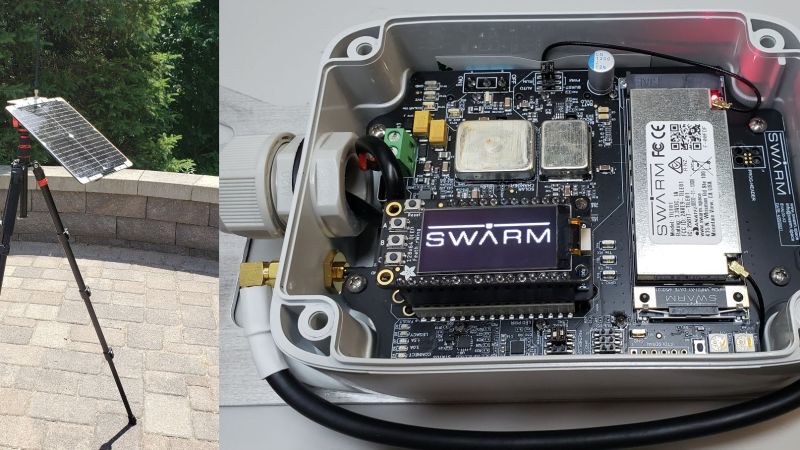In a world where it seems like everyone’s face is glued to a device screen, the idea that wireless service might be anything other than universal seems just plain silly. But it’s not, as witnessed by vast gaps in cell carrier coverage maps, not to mention the 70% of the planet covered by oceans. The lack of universal coverage can be a real pain for IoT applications, which is a gap that satellite-based IoT services aim to fill.
But which service is right for your application? To help answer that question, [Mike Krumpus] has performed the valuable work of comparing the services offered by Swarm and Iridium in a real-world IoT shootout. On the face of it, the match-up seems a little lopsided — Iridium has been around forever and has a constellation of big satellites and an extensive ground-based infrastructure. But as our own [Al Williams] discovered when he tested out Swarm, there’s something to be said for having a lot of 1/4U Cubesats up there.
[Mike] picked up the gauntlet and did head-to-head tests of the two services under real-world conditions. Using the same Swarm development kit that [Al] used for his test, alongside an Iridium dev board of his own design, [Mike] did basic tests on uplink and downlink times for a short message on each service. We couldn’t find specs on the test message length, but Swarm’s FAQ indicates that packets are limited to 192 bytes, so we assume they’re both in that ballpark. Iridium was the clear winner on uplink and downlink times, which makes sense because Swarm’s constellation is much smaller at this point and leaves large gaps in coverage. But when you consider costs, Swarm wins the day; what would cost over $1,500 with Iridium would set you back a mere $60 with Swarm.
The bottom line, as always, depends on your application and budget, but [Mike]’s work makes it easier to do that analysis.

















How does these things handle encryption/authentication to the iot server? Could normal TLS be used?
TLS would be waste of bandwidth. Something like NaCl secretbox has less overhead and does not need round-trip communication.
PHB insists on SSL and interactive authentication based on a GUI served off device… a couple of weeks later… bounds in holding Iridium bill for $10,000..
“That’s amazing, you’ve pushed it to all the customers and got it live already?”
“No, that’s Wednesday afternoon’s single device test session.”
There a definitely use cases for sat links but I can’t help but think most situations would do just fine with things like LoRa or DASH7.
Out of band management for ocean going vessels. West Texas / Montana stock tanks. EPA compliance water quality monitoring at decommissioned mines. Thousands of use cases where the nearest interconnectivity could be 50 or a thousand miles away.
Dash7 isn’t exactly ubiquitous and I wish LoRa was the answer but it’s not. There are massive gaps even in countries with a decent network infrastructure. Here in Ireland even in major cities the base stations are few and far between on all the major networks as it never really took off here and if you’re in a rural area there’s nothing, so cellular IoT is the only answer here. As for sea faring vessels or remote islands where cellular isn’t an option, satellite is the only way.
We (govt / contractors) use Iridium all the time. The handset – ie. 9575, is ruggedized and reliable. Short of using LST-5D’s with embedded comsec, the 9575 is our “go to” device in areas where we have no other backaul options. Flimsy consumer grade junk isn’t going to cut it when the end use is “mission critical”. Ergo price is not an object in our usage scenario.
Actually, if it weren’t for the US DOD, Iridium wouldn’t exist. Motorola was in the process of de-orbiting and dropping the satellites into the ocean when the phone rang….. It’s Uncle Sam.
I can’t really say more but almost all global satellite constellations are heavily funded and loaded by the US government.
Iridium SBD is quite expensive via Rock7. You can find much cheaper plans, but you will need your own DirectIP gateway. Unless you are sending really large amounts of data* you are still looking at around 0.5-1$ per kilobyte though.
*) In this case, also check if SBD is the product you want to use. Other options will likely be cheaper unless its a massive fleet that sends a lot of traffic in total, but each device sends only a few packets a day.
These services are quite different and don’t really compete in the same market. But if you’re considering a broad range, Viasat’s L-band MSS offers better performance than Iridium at a lower cost than Swarm.
Having to keep IT/OT/IoT infrastructures of OGVs, ocean going vessels online over L/Ka/Ku links, I can tell you that cost is not an issue for decades now as any solution is deployed with heavy promises of mission-critical SLAs that more or less are kept… All “alternatives” are not dense enough to sustain comm integrity and are not real-world production ready, up to this point in time.
I personally wish that real alternatives were available to detach from the Inmarsat/SES/Iridium monopolies that plague the SATCOMs
Swarm are claiming 2 hr latency but we’re finding it to be highly variable, 2-6 hrs.
What’s the best provider for Iridium SBD activation? I can’t seem to find anything with a simple self-serve activation process. For a hobby project I shouldn’t need to talk to a sales team. Using 9601 modems.
Satphonestore has SBD self registration, just fill the form with the IMEIs. No sales call needed for simple usage.
I ended up using Ground Control to begin with (they can do non Rockblock modems) but have since switched to Maxtena due to their support & antenna.